Related Research Articles

The Sand Creek massacre was a massacre of Cheyenne and Arapaho people by the U.S. Army in the American Indian Wars that occurred on November 29, 1864, when a 675-man force of the Third Colorado Cavalry under the command of U.S. Volunteers Colonel John Chivington attacked and destroyed a village of Cheyenne and Arapaho people in southeastern Colorado Territory, killing and mutilating an estimated 69 to over 600 Native American people. Chivington claimed 500 to 600 warriors were killed. However, most sources estimate around 150 people were killed, about two-thirds of whom were women and children. The location has been designated the Sand Creek Massacre National Historic Site and is administered by the National Park Service. The massacre is considered part of a series of events known as the Colorado Wars.

A land run or land rush was an event in which previously restricted land of the United States was opened to homestead on a first-arrival basis. Lands were opened and sold first-come or by bid, or won by lottery, or by means other than a run. The settlers, no matter how they acquired occupancy, purchased the land from the United States General Land Office. For former Indian lands, the Land Office distributed the sales funds to the various tribal entities, according to previously negotiated terms. The Oklahoma Land Rush of 1889 was the most prominent of the land runs while the Land Run of 1893 was the largest. The opening of the former Kickapoo area in 1895 was the last use of a land run in the present area of Oklahoma.

The Territory of Oklahoma was an organized incorporated territory of the United States that existed from May 2, 1890, until November 16, 1907, when it was joined with the Indian Territory under a new constitution and admitted to the Union as the state of Oklahoma.

The Dog Soldiers or Dog Men are historically one of six Cheyenne military societies. Beginning in the late 1830s, this society evolved into a separate, militaristic band that played a dominant role in Cheyenne resistance to the westward expansion of the United States in the area of present-day Kansas, Nebraska, Colorado, and Wyoming, where the Cheyenne had settled in the early nineteenth century.

The Battle of the Washita River occurred on November 27, 1868, when Lt. Col. George Armstrong Custer's 7th U.S. Cavalry attacked Black Kettle's Southern Cheyenne camp on the Washita River.
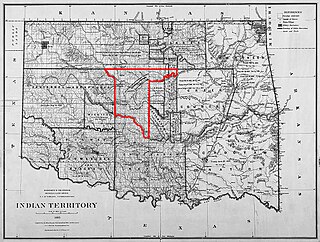
Sooners is the name given to settlers who entered the Unassigned Lands illegally in what is now the state of Oklahoma before the official start of the Land Rush of 1889. The Unassigned Lands were a part of Indian Territory that, after a lobbying campaign, were to be opened to American settlement in 1889. President Benjamin Harrison officially proclaimed the Unassigned Lands open to settlement on April 22, 1889. As people lined up around the borders of the Oklahoma District, they waited for the official opening. It was not until noon that it officially was opened to settlement. The name derived from the "sooner clause" of Proclamation 288 — Opening to Settlement Certain Lands in the Indian Territory, which stated that anyone who entered and occupied the land prior to the opening time would be denied the right to claim land.

David Lewis Payne was an American soldier and pioneer. Payne is considered by some to be the "Father of Oklahoma" for his work in opening the state to settlement.

The Unassigned Lands in Oklahoma were in the center of the lands ceded to the United States by the Creek (Muskogee) and Seminole Indians following the Civil War and on which no other tribes had been settled. By 1883, it was bounded by the Cherokee Outlet on the north, several relocated Indian reservations on the east, the Chickasaw lands on the south, and the Cheyenne-Arapaho reserve on the west. The area amounted to 1,887,796.47 acres.
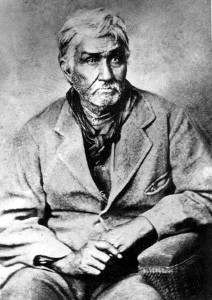
Jesse Chisholm was a Scotch-Cherokee fur trader and merchant in the American West. He is known for having scouted and developed what became known as the Chisholm Trail, later used to drive cattle from Texas to railheads in Kansas in the post-Civil War period.
The history of Oklahoma City refers to the history of city of Oklahoma City, and the land on which it developed. Oklahoma City's history begins with the settlement of "unassigned lands" in the region in the 1880s, and continues with the city's development through statehood, World War I and the Oklahoma City bombing.

The Colorado War was an Indian War fought in 1864 and 1865 between the Southern Cheyenne, Arapaho, and allied Brulé and Oglala Sioux peoples versus the U.S. Army, Colorado militia, and white settlers in Colorado Territory and adjacent regions. The Kiowa and the Comanche played a minor role in actions that occurred in the southern part of the Territory along the Arkansas River. The Cheyenne, Arapaho, and Sioux played the major role in actions that occurred north of the Arkansas River and along the South Platte River, the Great Platte River Road, and the eastern portion of the Overland Trail. The United States government and Colorado Territory authorities participated through the 1st Colorado Cavalry Regiment, often called the Colorado volunteers. The war was centered on the Colorado Eastern Plains, extending eastward into Kansas and Nebraska.
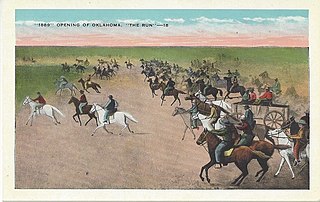
The Oklahoma Land Rush of 1889 was the first land run into the Unassigned Lands of former Indian Territory, which had earlier been assigned to the Creek and Seminole peoples. The area that was opened to settlement included all or part of the Canadian, Cleveland, Kingfisher, Logan, Oklahoma, and Payne counties of the present-day US state of Oklahoma.
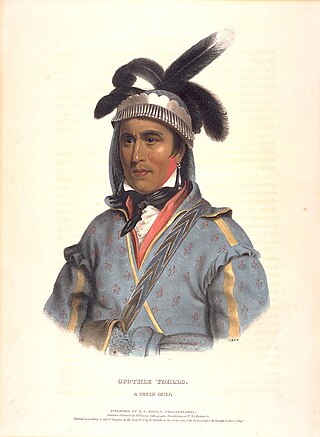
Opothleyahola, also spelled Opothle Yohola, Opothleyoholo, Hu-pui-hilth Yahola, Hopoeitheyohola, and Hopere Yahvlv, was a Muscogee Creek Indian chief, noted as a brilliant orator. He was a Speaker of the Upper Creek Council and supported traditional culture.
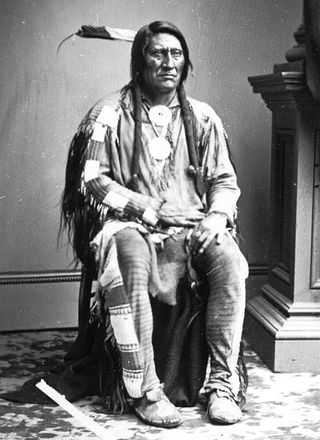
Lean Bear, alternatively translated as Starving Bear, was a Cheyenne peace chief. He was a member of the Council of Forty-four, a tribal governance devoted to maintaining peace with encroaching United States settlers. Lean Bear's most notable peace deals include the Treaty of Fort Wise and a meeting with US President Abraham Lincoln. His work towards peace between his people and the American settlers in the Southern Plains was cut short when he was killed by the 1st Colorado Cavalry Regiment and violent retaliations ensued.

The history of Oklahoma refers to the history of the state of Oklahoma and the land that the state now occupies. Areas of Oklahoma east of its panhandle were acquired in the Louisiana Purchase of 1803, while the Panhandle was not acquired until the U.S. land acquisitions following the Mexican–American War (1846–1848).
The Treaty of Fort Wise of 1861 was a treaty entered into between the United States and six chiefs of the Southern Cheyenne and four of the Southern Arapaho Indian tribes. A significant proportion of Cheyennes opposed this treaty on the grounds that only a minority of Cheyenne chiefs had signed, and without the consent or approval of the rest of the tribe. Different responses to the treaty became a source of conflict between whites and Indians, leading to the Colorado War of 1864, including the Sand Creek Massacre.
Clara Blinn was an American settler who, with her two-year-old son Willie, was captured by Native Americans in October 1868 in Colorado Territory during an attack on the wagon train in which she and her family were traveling. She and her little boy were killed on or about November 27, 1868 during or in the immediate aftermath of the Battle of Washita River, in which the camp of the Cheyenne chief Black Kettle was attacked and destroyed by troops of the Seventh U.S. Cavalry under the command of Lt. Col. George Armstrong Custer. Clara and Willie Blinn's bodies were found some two weeks after the fight in one of several abandoned Indian camps along the Washita River near present-day Cheyenne, Oklahoma.

"Boomers" is the name used for a group of settlers in the Southern United States in what is now the state of Oklahoma.

William Lewis Couch, a native of North Carolina and later a resident of Kansas, was best known as a leader of the Boomer Movement and as the first provisional mayor of Oklahoma City, Oklahoma in 1889. He joined the Boomer Movement in 1880 and became the sole leader of the movement after David L. Payne's death on November 28, 1884. He participated in the Oklahoma Land Run on April 22, 1889.
Rachel Anna Haines (1842-1912) was an American homesteader and a leader of the Boomer movement to open up the Unassigned Lands of Indian Territory. She was the common-law wife of David L. Payne and is sometimes referred to as the "Mother of Oklahoma."
References
- 1 2 Stan Hoig. 2000. Fort Reno and the Indian Territory Frontier. Fayetteville, Ark.: University of Arkansas Press, p. 82.
- 1 2 3 4 Carl Coke Rister. 1942. Land Hunger, David L. Payne and the Oklahoma Boomers, Norman, Okla.: University of Oklahoma Press, pp. 41, 45-50.
- 1 2 3 4 5 Stan Hoig. 1984. The Oklahoma Land Rush of 1889, Oklahoma City: Oklahoma Historical Society, p. 4.
- 1 2 Edward Everett Dale and Gene Aldrich. 1969. History of Oklahoma, Thompson Book and Supply Co., Edmond, Okla., 1969, first printing 1948 by Prentice Hall, Inc., New York, N.Y., pp. 231-234, 236.
- 1 2 Stan Hoig: "CARPENTER, CHARLES C. (dates unknown)", in Encyclopedia of Oklahoma History and Culture, Oklahoma Historical Society, http://digital.library.okstate.edu/encyclopedia/entries/C/CA060.html, n.d., accessed 8 Jul 2012.
- 1 2 John Y. Simon and Roger D. Bridges, eds. 1972. The Papers of Ulysses S. Grant, Volume 4: January 8-March 31, 1862, Carbondale, Ill.: Southern Illinois University Press, pp. 16-17.
- 1 2 Agnes Wright Spring. 1948. The Cheyenne and Black Hills Stage and Express Routes, first published in 1948 by the Arthur H. Clark Co., Glendale, Calif., reprinted by the University of Nebraska Press, Lincoln, Neb., A Bison Book, 1965, pp. 62, 66, 78.
- ↑ Kristen M. Taynor. 2009. A Guide to the Microfilm Edition of Military Intelligence during the Civil War, Provost Marshal Records on Spies, Scouts, Guides, and Detectives, Bethesda, MD: LexisNexis, p. 13.
- ↑ Frank Moore. 1889. Exploits of Capt. Carpenter of "The Jessie Scouts", in The Civil War in Song and Story, 1860-1865, New York: P. F. Collier, Publisher, pp. 45-47.
- ↑ Joseph G. Rosa. 1982. The West of Wild Bill Hickok, University of Oklahoma Press, Norman, Okla., p. 172.
- ↑ Joseph G. Rosa. 1964. They Called Him Wild Bill, University of Oklahoma Press, Norman, Okla., pp. 283-184.
- ↑ Reproduction of a poster titled "Grand Rush for the Indian Territory! Now is the Chance to Procure a Home in this Beautiful Country!" Advertisement for a colony leaving from Independence, Kansas on May 7, 1879 by the Kansas City, Lawrence & Southern Railroad, http://digital.libraries.ou.edu/WHC/nam/manuscripts/Tiger_Moty_T08_24.pdf%5B%5D, Oklahoma Federation of Labor Collection, Tiger, Moty Collection, Creek Nation, Folder 24. Western History Collections, University of Oklahoma, Norman, Oklahoma. Accessed 22 Nov 2012.
- ↑ Christine Fletcher. 1973. 100 Keys: Names Across the Land, Nashville: Abingdon Press, pp. 205-207.